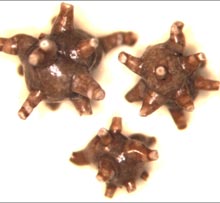A survivor’s guide to passing through the “stone”age…
 It’s a challenge to be cheerful about a dreadful subject but I’m trying to get my arms (small letters) around one lately – kidney stones. For anyone who has ever suffered through them, maybe I can share a relevant perspective here on the (not always so) little troublemakers. For those who have so far escaped the stones from hell, maybe I can help you stay free and clear.
It’s a challenge to be cheerful about a dreadful subject but I’m trying to get my arms (small letters) around one lately – kidney stones. For anyone who has ever suffered through them, maybe I can share a relevant perspective here on the (not always so) little troublemakers. For those who have so far escaped the stones from hell, maybe I can help you stay free and clear.
One good thing about kidney stones is that unlike heart disease, diabetes, etc. (the “silent killers”), they make a real racket and come to the party armed for bear. So you know what you’re dealing with. The pain you feel in your side(s) is triangulated somewhere between intense, overpowering, and you’ve got to be kidding. After my first stone, which drove me home from work for a week, I noted that it felt as if you’d laid down on your side in a driveway and a small truck loaded with bricks lurched up onto you and rocked back and forth, just above your hip.
My friend and co-worker Jim took one look at me that day and called down to our medical group. The medics quickly reached my office and asked a series of simple questions including my name and what day it was in an apparent attempt to see if I was still coherent or about to pass out. Between those fine fellows, the ambulance team and the wonderful folks in the Bridgeport Hospital emergency room (with a big hug to the angelic nurse who administered a shot of morphine), I sure made some nice new acquaintances.
That stone, a little 2 millimeter job, eventually passed after I dumped a tsunami on it by chugging at least six gallons of water and life marched on for a decade or so. Then several years ago, I developed two more stones and passed those as well (thank you Walgreen’s and your handy restroom). Little did I know that I was essentially whistling past the graveyard, as the next one, diagnosed this Spring, was too big to pass. The CT scan revealed that it was bullet shaped, 6×4 millimeters and not going anywhere good on its own. Oddly enough, it didn’t feel all that uncomfortable, though my urologist said it was putting my left kidney at risk and had to be removed. No choice. Take it or leave it, as long as you take it out.
Enter the ureteroscopy, which we scheduled as my hands shook and brain did cartwheels. This is a high tech clinical procedure, performed in a hospital, which uses a thin tube, tiny camera and laser to locate and break up the stone. Oh yes, and you get to go home with a stent in many cases—including mine. They said that all this is considered “low risk” and yes, you are completely anesthetized; that calmed me down for about a minute and a half.
We went ahead with it anyway at MUSC with my trusted urologist in charge. Door to door and back again, it was a 15 hour day (this included a remarkably reassuring, long conversation with a woman in the waiting room who had undergone this procedure previously and was having it again) and I am forever grateful to my friend Ralph for driving and keeping me company. He and my wife and two little dogs were my support team at home and I was never happier to have such help. And to be able to eat a regular meal after a two day hiatus from food.
Now for the fun part and some lessons learned. First of all, I will never look blankly at bathrooms again: they’re a wonderful invention. Or a glass of water, which it turns out is one of your best defenses for preventing stones. Back to that in a moment.
Second, it turns out that kidney stones are a distant cousin to precious stones. Well, sort of. The total cost associated with my run of the mill MUSC stone is approximately $20,000. This includes office visits, testing in both Beaufort and Charleston (ultrasound, x-ray and CT scan plus you know what samples) and then surgery with follow-up. The stone weighed approximately 0.3 grams or about 1.5 carats. If we prorate that (factoring 454 grams to a pound) we come up with a cost of $30.3 million per pound of stone which must mean that in total I’m worth – well a lot, medically speaking. And here’s a cool fact—that $20,000 can be compared to a roughly similar cost for a same sized diamond of good quality. Although if diamonds are forever, kidney stones are not. Thank heavens.
Which brings us back to the crucial business of avoiding future kidney stones. I say crucial because you can actually do a lot to steer clear of these abominations. Drinking a lot of clear liquids, especially water, goes a long way, as does weight loss. So does modifying your diet. Most kidney stones, about 80%, are calcium/oxalate and there is plenty of information on which foods contain dangerously high levels of oxalate. Turns out they’re all plants, and for me the skull and crossbones list means bidding a farewell to A.R.M.S., beginning with Almonds (plus most other nuts and absolutely anything that includes peanuts), Rutabaga, Marmalade, and Spinach (my hands down favorite vegetable).
There’s plenty more on this bad list, including brewed tea, blueberries, beets, celery, baked beans, and chocolate. But hey, there are many grown foods that are fine, including peeled apples, avocados, grapes, watermelons, zucchini, cabbage and turnips. So yes, the dietary glass is half full.
If I could wave a magic wand, it would be aimed at preventing anyone from suffering with kidney stones. There, “presto chango”! While urologists might earn less money in some cases, it sure would be nice to get the rest of us out of the “stone” age.







